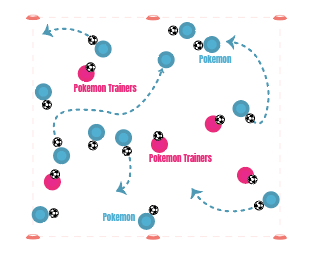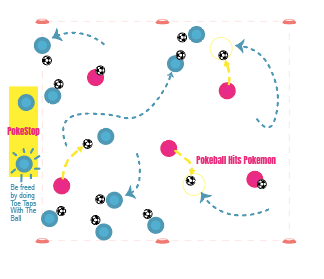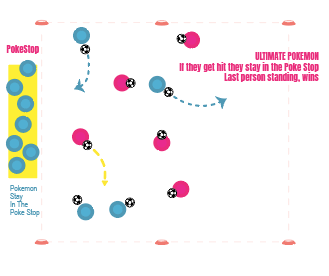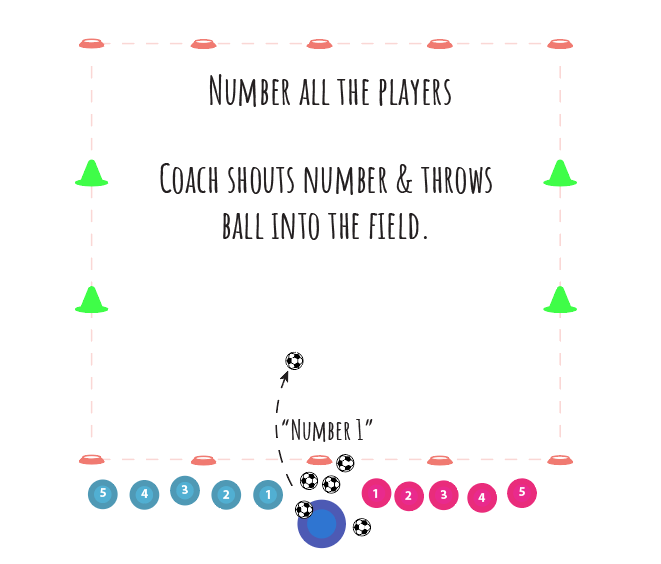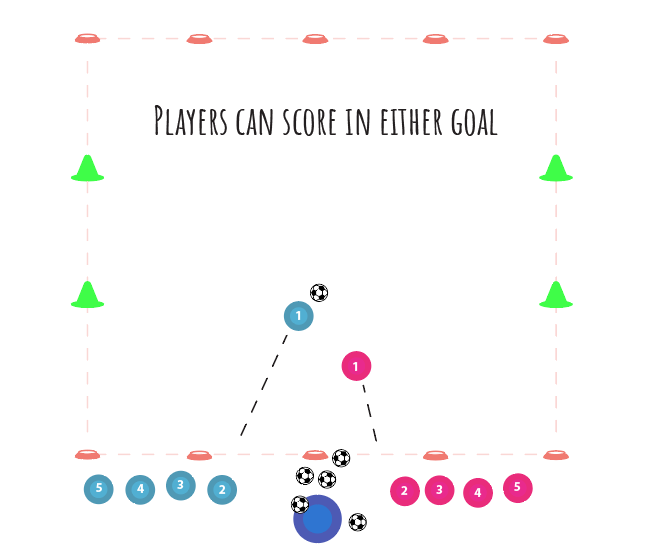Session 4.
Warm-Up
Free Play with Focus (2 minutes)
All players: Grab a ball and spend the next two minutes practicing whatever soccer skills you want to improve.
Age-Specific Suggestions:
Younger players: Try different ways to change direction while keeping the ball close to you. Can you stop quickly, turn, or dribble around cones?
Older players: Challenge yourself with juggling or advanced dribbling moves. How many juggles can you do in a row? Can you master a new dribbling trick?
Key Points:
The main goal is to let players have some fun and explore their skills.
The age-specific suggestions offer guidance but aren't mandatory.
If time allows, briefly demonstrate a few dribbling moves or juggling techniques before they start.
Game #1.
Pokemon Go - 15/20 minutes
Set Up
Playing Area: Create a large rectangular playing area with clear boundaries, ensuring enough space for running.
Pokémon Trainers: Select 3-5 students to be the Pokémon Trainers. They will wear colored pinnies for easy identification.
Pokémon: The remaining students are the Pokémon. Each Pokémon will have a soccer ball to dribble.
PokéStop: Designate a clearly marked area on the side of the playing field as the PokéStop.
How to Play
Trainer's Mission: The Pokémon Trainers, each holding a ball (their "Pokéball"), try to hit as many Pokémon's soccer balls as they can within 30-60 seconds. Trainers are allowed to run with the ball in their hand.
Pokémon's Goal: The Pokémon must dribble their soccer balls and try to avoid being hit by the Trainers' Pokéballs.
Caught Pokémon: If a Pokémon's ball is hit, they must go to the PokéStop and perform a designated soccer skill (like toe taps or a turn) to be freed and return to the game.
Out of Bounds Balls: If a ball goes outside the playing area, a designated ball retriever can quickly get it back in play.
Game Duration: The game ends after a predetermined time limit.
Rotate and Repeat: Switch out the Pokémon Trainers with new players and start another round.
Introduce New Condition
Elimination - Stuck in the PokéStop: Once caught, Pokémon stay in the PokéStop until all Pokémon are caught, adding a layer of strategy for the Trainers.
Faster Trainer Rotation: Rotate Trainers more frequently, like after they successfully hit five or ten Pokémon.
Younger Kids Adaptation: If a younger student gets hit, have them do jumping jacks on the spot instead of going to the PokéStop.
Skill Variety: Get creative! Change the skill required to be freed from the PokéStop, keeping it fun and engaging.
Safety First!
Ball Targets Only: Emphasize that Trainers must aim for the Pokémon's soccer balls, not their bodies.
Proper Throwing Technique: Demonstrate safe underarm and overarm throwing techniques.
Boundary Awareness: Clearly explain the playing area boundaries and the PokéStop, emphasizing that going out of bounds results in an automatic trip to the PokéStop.
Remember:
Keep the game fun and lighthearted.
Adjust the rules and progressions to fit the age and skill level of the players.
Make sure everyone understands the rules and safety guidelines before starting.
Encourage fair play, teamwork, and good sportsmanship.
Game #2.
Numbers Scoring - 15/20 minutes
Set-up
Field and Goals: Set up a playing area with a goal at each end.
Teams: Divide the players into two teams.
Number Assignment: Assign each player on both teams a number. Team A = 1,2,3 etc. Team B = 1,2,3 etc.
How to Play
Coach Calls a Number: The coach shouts out a number (e.g., "Number 3!").
1v1 Challenge: The players with that number from each team compete for the ball and try to score in either goal.
Freedom of Movement: Players can dribble, turn, and change direction as much as they need to evade their opponent and create scoring opportunities.
Skill Development
Ask the students…”Show us your best moves! When it's your turn to play, use those fancy turns and fakes to leave your opponent in the dust. The more you turn, the more space you'll create to score!"
Question to Spark Thought
"How can you use turns to your advantage in this game? Think about how you can use different types of turns to get away from your defender and find a path to the goal!"
Additional Tips
Demonstrate: Before the game starts, quickly demonstrate a few effective turning techniques.
Positive Reinforcement: During the game, point out instances where players successfully use turns to evade defenders.
Adjust for Age/Skill Level: For younger or less experienced players, focus on basic turning movements. With older or more skilled players, you can encourage more complex turns and fakes.
Remember to keep the instructions clear, concise, and encouraging!
Introduce New Conditions
2v2: The coach calls out two numbers (e.g., "Numbers 2 and 5!"). The corresponding players from each team work together to score.
3v3: The coach calls out three numbers, and those players from each team collaborate to score.
Scrimmages
Set Up
Divide the players into two groups and organize a 5v5 game on each field.
Use the bibs to clearly distinguish the teams.
Your Role
Facilitate Understanding: Make sure the players understand the basic rules of the game. Clarify any questions they have and ensure everyone is on the same page.
Skill Integration: At the beginning of each game, remind the players of the specific skill they practiced during the warm-up and the fun games. Encourage them to actively try and use that skill during the game. Example: If the games focused on dribbling, you might say something like, "Remember those dribbling moves we just practiced? Let's see you use them to get past defenders and create scoring chances!"
Additional Tips
Observe and Provide Feedback: Watch the games closely and offer positive feedback and constructive suggestions to individual players and teams.
Keep it Fun: Maintain a positive and encouraging atmosphere. The main goal is for the kids to enjoy playing and learning.
Be Flexible: Adjust the game format or rules if necessary to ensure everyone is engaged and having a good time.
Remember, your enthusiasm and guidance will go a long way in helping the players develop their skills and love for the game!
End Chat
Bring the group in at the end of the session and ask questions about the what they just worked on. Examples:
Q. What did you do in the session?
Q. What did you learn?
Give stickers out to kids who did well.
Choose a child who did a great job and they choose the end cheer for the group.



